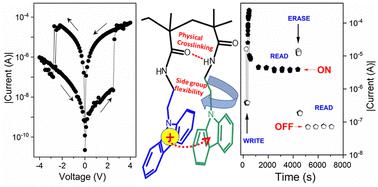当前位置:
X-MOL 学术
›
J. Mater. Chem. C
›
论文详情
Our official English website, www.x-mol.net, welcomes your
feedback! (Note: you will need to create a separate account there.)
Rewritable resistive memory effect in poly[N-(3-(9H-carbazol-9-yl)propyl)-methacrylamide] memristor
Journal of Materials Chemistry C ( IF 5.7 ) Pub Date : 2023-11-28 , DOI: 10.1039/d3tc03394e Yadu Ram Panthi 1, 2 , Jiří Pfleger 1 , Drahomír Výprachtický 1 , Ambika Pandey 1, 2 , Muhammed Arshad Thottappali 1, 2 , Ivana Šeděnková 1 , Magdalena Konefał 1 , Stephen H. Foulger 3, 4
Journal of Materials Chemistry C ( IF 5.7 ) Pub Date : 2023-11-28 , DOI: 10.1039/d3tc03394e Yadu Ram Panthi 1, 2 , Jiří Pfleger 1 , Drahomír Výprachtický 1 , Ambika Pandey 1, 2 , Muhammed Arshad Thottappali 1, 2 , Ivana Šeděnková 1 , Magdalena Konefał 1 , Stephen H. Foulger 3, 4
Affiliation

|
The synthesis of poly[N-(3-(9H-carbazol-9-yl)propyl)methacrylamide] (PCaPMA) is presented, along with its physical, photophysical, and electrical properties, revealing its promising potential for the application in bistable memory devices. The incorporation of the carbazole heterocycle, as a functional charge carrier transporting unit attached to a saturated polymethacryalamide backbone by a flexible alkyl chain, facilitates resistive switching by the applied voltage. Thin films of the polymer, sandwiched between Al or Au and ITO electrodes, exhibit rewriteable flash memory behavior with bistable conductivity with a setting voltage ranging from 2 to 4.5 V, achieving a current ON/OFF ratio exceeding 100. The device demonstrates a remarkable lifetime and remains persistent for more than 104 seconds under a static voltage of 0.5 V. The main physical mechanisms driving the resistive switching have been attributed to the electric field-induced reorientation of heterocycles, which modulates charge transport, and trapping/detrapping of charges in localized states within the bulk of the polymer. Memory persistence is strengthened by the physical crosslinking caused by hydrogen bonds between amide and carbonyl groups in the aliphatic side chains. This physical network further enhances the thermal and mechanical stability of the PCaPMA in comparison to similar polymers highlighting its potential as a suitable material for organic memory devices.
中文翻译:

聚[N-(3-(9H-咔唑-9-基)丙基)-甲基丙烯酰胺]忆阻器中的可重写电阻记忆效应
介绍了聚[ N- (3-( 9H-咔唑-9-基)丙基)甲基丙烯酰胺](PCaPMA)的合成,及其物理、光物理和电学性质,揭示了其在双稳态中的应用前景存储设备。咔唑杂环的引入,作为通过柔性烷基链连接到饱和聚甲基丙烯酰胺主链的功能性电荷载流子传输单元,有利于通过施加的电压进行电阻切换。夹在 Al 或 Au 和 ITO 电极之间的聚合物薄膜表现出可重写闪存行为,具有双稳态导电性,设置电压范围为 2 至 4.5 V,电流开/关比超过 100。该器件表现出卓越的使用寿命并在 0.5 V 的静态电压下保持持续超过 10 4秒。驱动电阻开关的主要物理机制归因于电场引起的杂环化合物的重新取向,其调节电荷传输以及电荷的捕获/去捕获聚合物本体中的局域态。脂肪族侧链中酰胺和羰基之间的氢键引起的物理交联增强了记忆持久性。与类似聚合物相比,这种物理网络进一步增强了 PCaPMA 的热稳定性和机械稳定性,凸显了其作为有机存储器件合适材料的潜力。
更新日期:2023-11-28
中文翻译:

聚[N-(3-(9H-咔唑-9-基)丙基)-甲基丙烯酰胺]忆阻器中的可重写电阻记忆效应
介绍了聚[ N- (3-( 9H-咔唑-9-基)丙基)甲基丙烯酰胺](PCaPMA)的合成,及其物理、光物理和电学性质,揭示了其在双稳态中的应用前景存储设备。咔唑杂环的引入,作为通过柔性烷基链连接到饱和聚甲基丙烯酰胺主链的功能性电荷载流子传输单元,有利于通过施加的电压进行电阻切换。夹在 Al 或 Au 和 ITO 电极之间的聚合物薄膜表现出可重写闪存行为,具有双稳态导电性,设置电压范围为 2 至 4.5 V,电流开/关比超过 100。该器件表现出卓越的使用寿命并在 0.5 V 的静态电压下保持持续超过 10 4秒。驱动电阻开关的主要物理机制归因于电场引起的杂环化合物的重新取向,其调节电荷传输以及电荷的捕获/去捕获聚合物本体中的局域态。脂肪族侧链中酰胺和羰基之间的氢键引起的物理交联增强了记忆持久性。与类似聚合物相比,这种物理网络进一步增强了 PCaPMA 的热稳定性和机械稳定性,凸显了其作为有机存储器件合适材料的潜力。






























 京公网安备 11010802027423号
京公网安备 11010802027423号